
BLOG
Richard L. Bowman, PhD; retired physics professor and ordained minister
Additional Resources
I have gotten a bit behind in publishing the photos, audio and blog entries for the monthly Elder Exchange Forums, but I am now caught up. Hopefully I can stay that way.
Here are some references for resources that refer to the various presentations over the past few months. Take a look at them as you can to learn more about our monthly topics. They are in reverse chronological order.
Migrants and Immigration
-
Immigration detainee care kits give dignity & show Christ's love (Mennonite Central Committee):
https://mcc.org/stories/caring-strangers-through-new-kits-partnerships -
Immigration Update from the MCC Washington Office:
https://mcc.org/stories/immigration-update-30 -
Our work with displaced persons (Church World Service):
https://cwsglobal.org/our-work/refugees-and-immigrants/ -
A short email mini-course on immigration (Pew Research Center):
https://mailchi.mp/pewresearch.org/u-s-immigration-mini-course
Young Adults and Christ's Church
-
Aaron Kauffman, DMin dissertation: "Thriving : effective strategies for the evangelism and discipleship of emerging adults:"
https://place.asburyseminary.edu/ecommonsatsdissertations/1390/ (download full text) -
Research supported by Aspen Group, "Making Space for Millennials: Executive Summary"
https://info.aspengroup.com/hubfs/Downloadable_Resources/MSFM_Ex_Summary_final.pdf?t=1499780175078
The Historical Adam and Early Humans
-
Genesis Proclaimed Association (Dick Fischer's program):
http://www.genesisproclaimed.org/
Click on the image for "Creation Genesis, and Origins" to see links to a six-part video series on YoouTube. -
American Scientific Affiliation (an association of scientist who acknowledge they are Christians, many of whom hold to a theistic evolution viewpoint and an evangelical Christian faith):
https://network.asa3.org/default.aspx
Samuel Augsburger on God and Science
-
The book: Slices of God: Strange, Dimensional, and Fractal Perspectives on God and the Cosmos
https://www.amazon.com/gp/product/0692468358/ref=dbs_a_def_rwt_bibl_vppi_i0 -
"Slices of God" (Samuel Augsburger's blog):
https://www.slicesofgod.com/?author=1
--Richard L. Bowman (8-Mar-20)
Discussion
To add a comment, please fill in and submit the "Contact Form" below.
Possible Space Travel to Mars and Distant
Stars
and Christian Faith Considerations
Timeliness of the Topic
As I was getting ready for my presentation on June 13, I realized afresh that thus summer is the 50th anniversary of the first human to walk on the Moon. But then even more connected to my thesis, raising doubts about the advisability of human travel to Mars or distant stars, were the results from a survey presented by NPR a week later. The survey conducted by AP and U. of Chicago showed that, "Two-thirds of respondents said monitoring asteroids, comets and 'other events in space that could impact Earth' was 'very or extremely important'" (as reported by NPR).
Here is the address to the NPR article:
https://www.npr.org/2019/06/20/734311961/poll-americans-want-nasa-to-focus-more-on-asteroid-impacts-less-on-getting-to-ma
Here is the address to the original report from
the survey conductors:
http://www.apnorc.org/projects/Pages/Space-Exploration-Attitudes-toward-the-U-S--Space-Program.aspx
To cite NPR once more, just today they issued
another article, "Robots, Not Humans, Are The New Space Explorers."
https://www.npr.org/2019/07/08/733714689/robots-not-humans-are-the-new-space-explorers
As followers of Jesus Christ, we often step to a different director. But it is interesting that the general US society also questions the advisability of putting so much of resource capital into attempting flights with humans to Mars and other planets or even close-by stars.
Issues from the Respondents
I really appreciated Laura's and Daniel's comments after my presentation.
Laura noted among many other good ideas that whatever we do is not going to restrict the Holy Spirit's work among human's, so I will have to reconsider how to word my issue about evangelism not happening if no Christian is aboard a spacecraft on a long journey.
Daniel reminded us that I considered only one way to accelerate a spacecraft, i.e., by a spacecraft carrying all of the fuel it will need for the whole journey. One suggestion that showed up in his reading was to use a passenger ship by itself with a powerful laser sending energy to the ship through photons. So, let's look at that briefly. While we will have some assumptions built into this calculation, it is definitely on the correct order of reality.
For a Gaussian shaped light beam output, the angle from the direction of the maximum in the beam to the edge at 1/e2 as the beam propagates outward is given by:
angle = wavelength/(pi*w0), where w0 = the radius at the narrowest point iin the beam.
If we use a 1.0 cm diameter beam at a wavelength of 500 nm, then angle = 31.8 microradians.
At only one light year away, this finally translates to a radius of the beam ~ 300 Mm ~ 200 million miles.
Since the Earth is 1 AU = 93 million miles on the average from the Sun, this answer means that if the spacecraft is to capture all of the energy from the laser, we would need a light sail that has a diameter of 4 AU and with a laser aimed directly at the center of the sail.
This precision in pointing the laser is very crucial because any communication to the spacecraft to adjust its path will take a year to get to the spacecraft!
To Ponder:
Take a look at the presentation (that is now online here) and share any other ethical questions you would consider or which ones you would ignore.
--Richard L. Bowman (9-Jul-19)
Discussion
To add a comment, please fill in and submit the "Contact Form" below.
Christians and the Built Environment
Introduction
Architect and contractor Randy Seitz, along with respondents Wallace Hatcher and Dee Weikle, presented an enjoyable and thoughtful Elder Exchange forum entitled "The Space Between: A Christian Engagement with the Built Environment” on Thursday evening (9-May-19). Here I will define two terms in writing, give details on how to access the books Randy mentioned, and focus on the question of does our environment define us or do we define our environment.
Built Environment - Wikipedia says this concept "refers to the human-made surroundings that provide the setting for human activity." It is basically the made environment that surrounds us as we live out our lives as opposed to the aspects of where we live that might be called the natural environment.
The Space Between - As reported by Matthew Sleeman in a review, "It alludes both to the built environment which, as more than architecture or town planning, is also concerned with relationships between buildings within a wider sense of 'enacted space', and to the eschatological time and space which our urban forms occupy, between Christ's first and second comings to earth."
Resources
Eric O. Jacobsen. The Space Between: A Christian Engagement with the Built Environment Kindle Edition. Baker Academic, 2012. Amazon (paperback and Kindle versions)
Philip Bess. Till We Have Built Jerusalem: Architecture, Urbanism, and the Sacred. Intercollegiate Studies Institute, 2006. Amazon (paperback).
FROM MY SEARCHES
Adina Hoffman. Till We Have Built Jerusalem: Architects of a New City. Farrar, Straus and Giroux, 2016. Amazon (paperback and Kindle) - a practical review of three architects who have worked on Jerusalem, Israel, in the past century and how they applied their ideas on built environment.
Peter W. Williams. Architecture, the Built Environment, and Religion in America. (Oxford Research Encyclopedia, 2018) - explores how the different waves of immigrants brought their religoous views with them and thus affected worship architecture in the US.
T. J. Gorringe. A Theology of the Built Environment: Justice, Empowerment, Redemption. Cambridge U., 2002. (Amazon: Kindle, hardcover, and paperback) - the title says it all; a free pdf of the first 20 pages is available from CUP here.
Brian Gray. "Questions for Christian Engineers, Architects, Designers and Urban Planners." (Denver Institute for Faith and Work, 2014) - excellent questions to ponder;
Jeff Haanen. "David Greusel: Architecture for Human Flourishing" [includes videos]. (Denver Institute for Faith and Work, 2015) - again, more thinngs to ponder in the connection between our built environment and people.
For free courses (with videos) from the Denver Institute, sign up for a free account in Scatter.
Henry David Thoreau. Walden. Enhanced Media, 2017. (Amazon: Kindle and other versions) - Thoreau, with his background in New England Christianity, considers both the built and natural environs in this classic.
To Ponder: Which Comes First--Our Culture and Theology or Our Build Environment?
Question:
Does our style of worship come from our theology or does the built environment of the church building affect our view of the "church" and how how we can be God's people?
I will just lead us in a brief review of current educational practice at the elementary level (which has also for several decades been suggested at aall educational levels). Below is a sketch of two classrooms. One is in the traditional rows of student desks with the teacher's desk at the front of the classroom. The other one is geared for small groups or indivudual work teaching interactively and collaboratively.
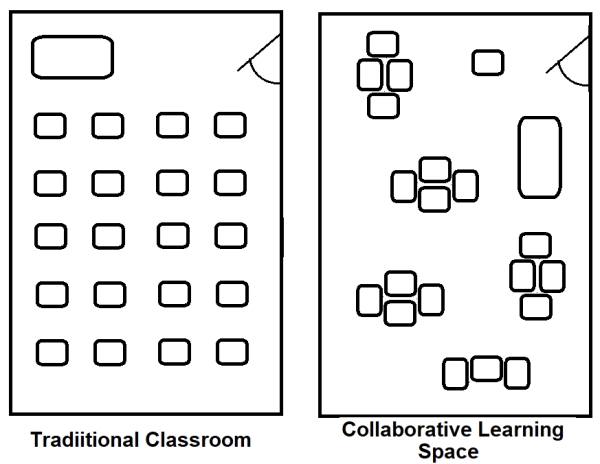
As educators, we are told again and again that lecturing is usually not the most effective way to help persons learn and retain what they have learned. In fact "the sage on the stage" is often contrasted with the more effective "guide on the side of." Read the article, "Forget ‘Sage on the Stage,’ and ‘Guide on the Side’" for a readable think piece in our current political situation.
Now how might we apply these ideas to church buildings? Does having a minister at the center of a stage behind a pulpit imply that that person is more Christian than anyone in the audience? I seems to me that while contemporary worship service may have a good idea in mind, replacing pews with chairs, I have not been in any service that truly made use of the capabilities of such an arrangement. That is, chairs can easily be grouped into small circles to allow interactive listening, brainstorming, and Bible study. In fact might a darkened room with a brightly lit stage and performers lead even more toward the idea of labeling the persons on the stage as the epitomes of Christians.
One more reference to ponder. Carey Nieuwhof writing in "7 Disruptive Church Trends That Will Rule 2018" and "5 Disruptive Church Trends That Will Rule 2019" shares his views on how digital and in-person churches have and will change. Many things to consider.
Suggestion:
So what might I suggest? How about each building committee and each design and build committee have at least one minist on it who can help the committee address some of the issues. The outcomes could include a reduced grandeur for the pulpit and the stage, more though and money put into the construction and outfitting of classrooms for small group and Sunday School classes, and considering how to make the building as multi-purposed as possible. This last idea should be aimed at the community as well as the congregation using the new or newly remodeled facilities.
Conclusion
Let's continue the conversation.
--Richard L. Bowman (12-May-19)
Discussion
To add a comment, please fill in and submit the "Contact Form" below.
Resources for Relating to Persons with Dementia and Their Families
Thanks to Mary Kay Adams, Valda Garber-Weider, and Kristopher Schmidt for an informative evening at January's Elder Exchange. To help out any persons find appropriate web resources, I have a number of links below.
A. Links from my own research.
Download the Free Alzheimer’s App from Help for Alzheimer's Families
Alzheimer's care: Simple tips for daily tasks from the Mayo Clinic
Alzheinmer's Disease and Related Dementia, National Institute on Againg.
Mechanisms of Alzheimer’s Disease Pathogenesis and Prevention: An Update, and academic article
Neuropathology, Chapter 9: Degenerative Diseases
B. Links I culled from Mary Kay's presentation file.
Alzheimer's Association -- https://www.alz.org/
- 10 Tips for Living with Alzheimer’s
- 10 Ways to Help a Family Living with Alzheimer’s
- There are also various "Caregiver’s 10 Commandments." Search and read them online; choose the one that suits you best. --RB
Do Not Ask Me to Remember by Owen Darnell
A Prayer for the Caregiver by Bruce McIntyre
The Journey of Accompaniment. Studies in Christian Ethics 2016, Vol. 29(3) 294—300 by John Sherrington, London, UK
Where is God when dementia sneaks into our house? Practical theology and the partners of dementia patients by Maria Bons-Storm, 2016 HTS Teologiese Studies/Theological Studies 72(4), a3227.
C. Links to academic journals that I pulled from Kristopher's presentation file.
J. Jin, Alzheimer Disease, JAMA, 2015
J. Hidalgo, et al., Expression of Metallothionein-I, -II, and -III in Alzheimer Disease and Animal Models of Neuroinflammation, Exp. Biol. & Med., 2006
J. Attems, et al., The relationship between subcortical tau pathology and Alzheimer's disease, Biochem. Soc. Trans., 2012
J. Mendiola-Precoma, et al., Therapies for Prevention and Treatment of Alzheimer’s Disease, BioMed Res. Int., 2016
Conclusion
We are all on the journey, so let's share humbly generously and gratefully.
--Richard L. Bowman (29-Jan-19)
Discussion
To add a comment, please fill in and submit the "Contact Form" below.
Climate Change, Model Fitting & Extrapolation:
Not an Exact
Science
As a retired professor of physics and director of academic computing, I am one of the mass of scientist whom Doug Graber Neufeld identified in his December 12 presentation as holding to the idea that climate change is occurring and that humans as contributing to it. However, I am not sold on the extrapolations nor the curve fitting that was shown. Here is one plot showing what I have many doubts about.
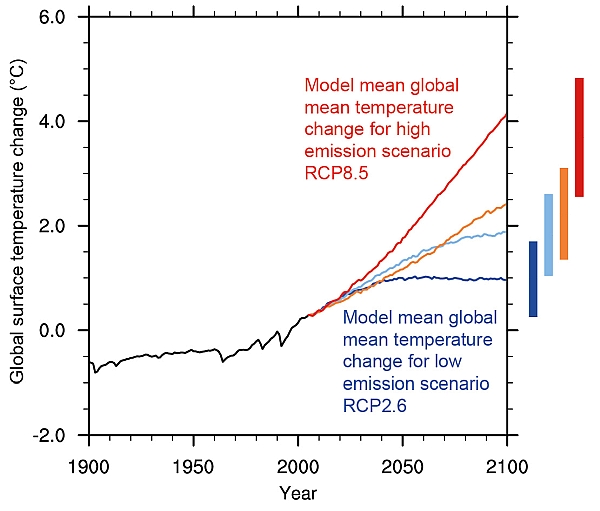
Source: Chapter 12 in IPPC's "Climate Change 2013 ( https://ar5-syr.ipcc.ch/resources/htmlpdf/WG1AR5_Chapter12_FINAL/ )
A. Curve Fitting (Model Building)
The simplest form of mathematical building is fitting a curve to some data. Climate models are much more complex than that today. However, as Christoph Baumberger, et. al. noted in their recent article: "Building confidence in climate model projections: an analysis of inferences from fit," WIREs Clim Change 2017, https://doi.org/10.1002/wcc.454 .
"To begin with, the fit of model results to data is far from perfect. Each of today’s climate models is known to give many results that do not come close to matching data within observational uncertainty and variability...."
These uncertainties in climate models come from mainly two sources: uncertainty in the data and uncertainty in the parameters of the model.
To help us understand how complicated a climate model is, here is one mathematical climate model.
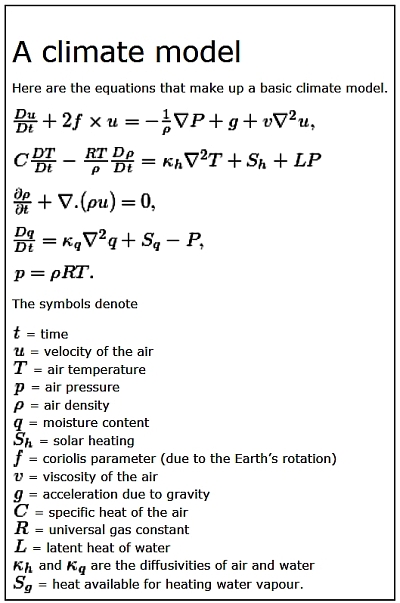
Source: https://plus.maths.org/content/comment/8383#comment-8383
Many models are fit to at least some data, i.e., several ordered sets of data are observed and theen the climate model has its parameters adjusted to best fit the model to the data sets.
Different models can fit the same data, if one is doing curve
fitting. To illustrate this, I have modeled the global mean temperature
difference from 1880 through 2017 with the average of 1951-1980
providing the base value. The raw data can be found at:
https://data.giss.nasa.gov/gistemp/graphs/graph_data/Global_Mean_Estimates_based_on_Land_and_Ocean_Data/graph.txt
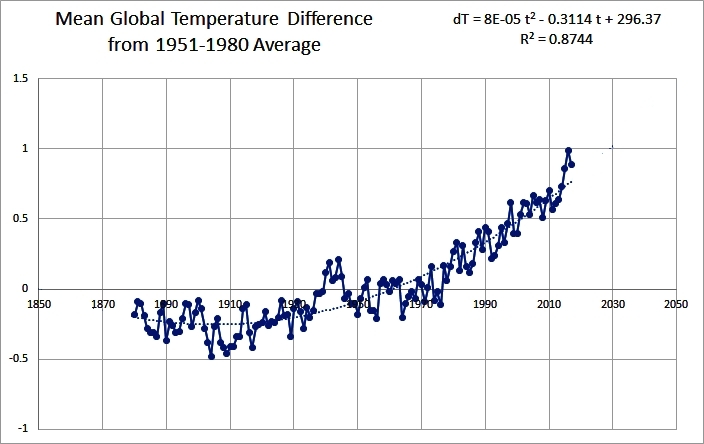
Fig. 1. The Mean Global Temperatures Fit to a t-squared Polynomial
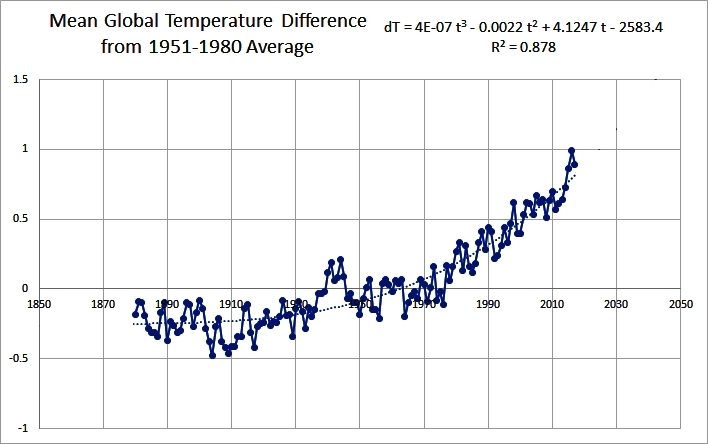
Fig. 2. The Mean Global Temperatures Fit to a t-cubed Polynomial
Notice that there is no visible differences between how the fit lines (dashed) fit the data. Even the R-squared values are extremely close. In this case for the data given, one cannot aruge that one model is better than the other one.
B. Extrapolation of the Models
The cartoon below illustrates some of the risks of extrapolating mathematical models formed from limited data. It is a humorous, at least to me!
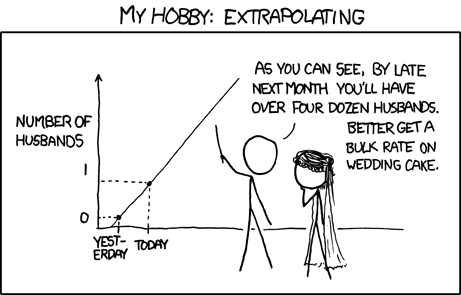
Source: https://imgs.xkcd.com/comics/extrapolating.png
Extrapolating from a curve-fitted function is very risky. At best it is only useful over a short extension. Below are the two models derived for the above data in Figures 1 and 2 extrapolated approximately 30 years on each side of the data.
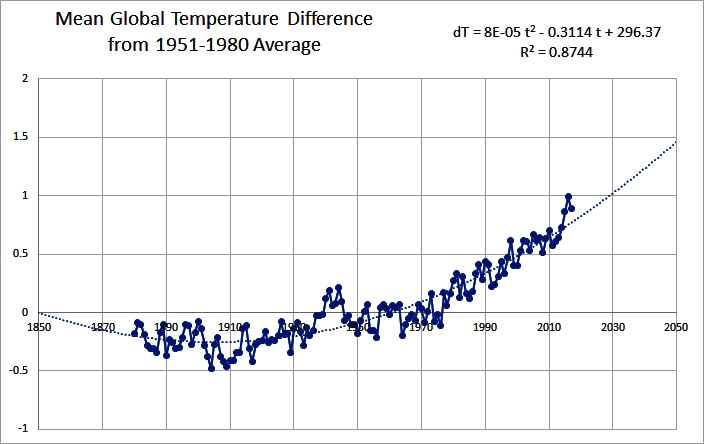
Fig. 3. The Mean Global Temperatures Extrapolated with a t-squared Polynomial
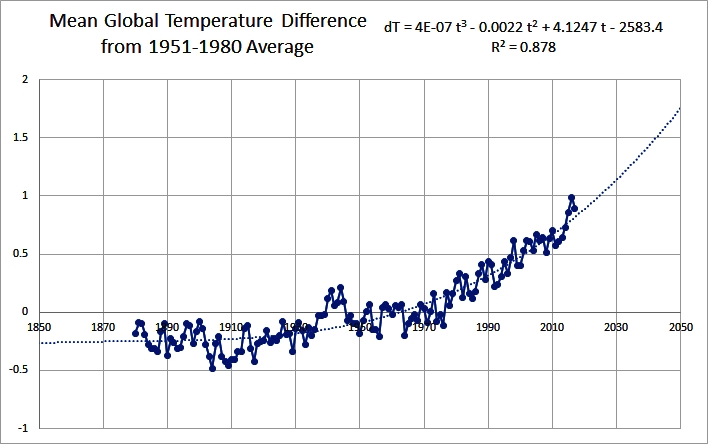
Fig. 4. The Mean Global Temperatures Extrapolated with a t-cubed Polynomial
Notice that these two models, while fitting the original data equally well, end up with different values when extrapolated. The t-squared polynomial function predicts that there had been a temperature at -0.25o C below the average in 1850 and that there will be a 1.5o C rise in 2050. On the other hand, the t-cubed polynomial function predicts that there had been a 0o C difference in 1850 and that there will be a 1.75o C difference in 2050.
C. Fitting Data from Further in the Past
One more piece of information makes me skeptical about the data extrapolated from climate m odels, and that is that I have not seen any yet that got back 850,000 years or even 100,000 years. Ice core data does give us estimates of what the mean global temperatures were back that far, but the models do not work with those data sets. Here is one plot of such data.
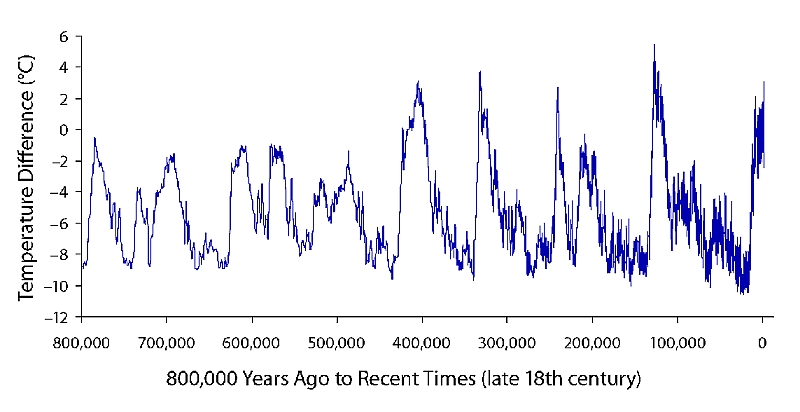
Fig. 5 Plot of Mean Global Temperatures as Inferred from Trapped Gasses in Antarctic Ice Cores
This data is from a National Academy of Sciences book and can be accessed at: https://nas-sites.org/americasclimatechoices/files/2012/10/Figure-14.png .Many of the down swings can be explained by volcanic eruptions, large meteor impacts, etc. But what we do not know is if there are other functions that help keep Earth's temperatures moderate enough for life as we know it. In many other situations nature seems to prefer stasis--equilibrium of various variables within certain limits. Might this be the case for climate changes?
Conclusion
There is no question that humans are adding carbon dioxide, methane, and nitrous oxide into the atmosphere at rates never known before. Thus we need to consider what we can do to reduce these human-inflicted changes. But we also do not know enough about all of the factors influencing mean global temperatures and other climate variables to do the huge extrapolations that climate change advocates often seem to promulgate. Share your thoughts below.
--Richard L. Bowman (6-Jan-19)
Discussion
To add a comment, please fill in and submit the "Contact Form" below.
name = D. Neufeld; comment = Very nice! You really have a good thing going with these exchanges, and the website adds nicely to that.
name = E. Rempel; comment = Interesting! Looking forward to newsletters. (10-Jan-19)
Share in the Discussion
Your comments to this blog or any of the Elder Exchange presentations are solicited and welcomed. This discussion is moderated by Richard Bowman ( rebowmanmail@gmail.com ), one of the conveners of Elder Exchange. I will try to post appropriate and respectful comments that may agree or disagree with the content provided here on in the presentations. Any views expressed are those of the person submitting them and not necessarily supported by Richard or Roman or any of the sponsoring organizations.